Ya, I guess we maybe lean a little to the left!! --- ;^}
My '54 Hudson, da Poupon, at the Dallas MOCNA MEET, in '92 -- Gotta first place!!
This'll take a bit (up to 20 minutes) to load
Here's some interesting
stuff to read while the images load ---
FROM THE MAY 1954 MOTOR TREND MAGAZINE
THERE ARE FEW ENOUGH times in the life of
an automotive editor that he can wax enthusiastic about a new idea.
Now is the time.
Two issues ago we brought you some up
to the-minute news about a new concept in cars - the Nash Metropolitan.
Don MacDonald, our Detroit Editor, made an extremely good point when he
said (May '54 MT), "If this car doesn't attack the American small car market,
there is no such market!"
From what we've seen of the number of
these mighty mites on California's streets and highways, we'd say that
there is such a market. According to one late report issued by Nash
Division of American Motors, over 8000 Metropolitans have been sold since
the car's introduction in mid-March. This is evidently well above
expectations, since President George Mason originally announced a 1954
total production figure of 10,000. And since that time, production
has been increased.
Those of you who are steady readers will
recall that we gave you a fairly comprehensive description and trial run
report (May '54 MT) of the Metropolitan from Detroit. On top of what
MacDonald did with that convertible (drove it for 300 miles) we really
put a hardtop through the paces stuck our foot in it to Pebble Beach from
Los Angeles and return, 600 miles, then over our usual test course, piling
up 1668 miles on the car. This isn't the type of driving the car
was designed for; any virtues it has for cross-country treks can be considered
to be a bonus, just as any drawbacks it has should be construed as unimportant
to the car's intended purpose.
Seldom has a car tested by the MT Re-search
staff caused as much controversy as the Metropolitan. Opinion is
as widely varied as on who's going to win the pennant. Here are some
sample statements.
"This car's potential is great I predict
it will outsell its cousin, the Rambler! It should be extremely popular
with those Americans who are now ready for a Second car-for the wife or
for the man who wants cheap transportation to and from his job."
This by Jim Potter.
Pete Molson compared it to what you could
get in a used car at its price ($1445 FOB, port of entry). "If someone
really likes it better than all the used cars he could get for this price,
he couldn't seriously be advised against it. It's a simple car with
little to go wrong with it, but it's minimum transportation."
Jim Lodge disagreed with the above"Not
my kind of car, but definitely my idea of what a small car should be.
It's a pleasure to drive, is ready and willing for anything."
Fred Bodley thought that its chassis design followed tried and proven
methods that should give reasonably trouble-free service with a minimum
of upkeep. He also said, "As a second or transportation car, it's
hard to beat. Comfort is adequate for this type of driving and economy
is excellent"
My opinion? This car can unseat many neo-sports car owners, those
who are driving that type of car because they want a small open car with
good performance and outstanding economy. Its handling and maneuverability
make it fun to drive; the Nash service organization is such that an owner
won't have trouble having his car serviced.
Looking Out
Unlike many small cars, the Metropolitan isn't hard to get into
or out of. Once inside you'll find the seat not overly padded nor
deep enough for driving comfort on long trips. On the other hand,
you can vary the leg room easily with the manual seat adjustment.
Whether you're driving or are a passenger you'll be fairly comfortable,
since there's room to spraddle out in. You can stretch your legs,
don't have to sit sideways to make room for your shoulders, and won't hump
the top with your head unless you're mighty tall in the saddle.
Vision in all directions is exceptional. The forward view
through the one-piece, flat windshield is unmarred by the corner posts
or the rear view mirror. You can see all four fenders without straining.
Readability and Driving Ease
The steering system on the Metropolitan consists of equal-length
tie rods with cross linkage and idler arms. It gives fairly positive
control, not requiring constant correction on a straight road; neither
is there much wind wander. With its small number of turns lock to
lock (2½) it has fairly quick control. Coming back from Pebble
Beach I was fascinated by being able to whip it into corners at speeds
that went up progressively and were much faster than I thought was possible.
Remember, this isn't supposed to be a sports car, yet in this respect it
seems to have some of the sports car characteristics. It was actually
hard to break the rear end loose; it only happened in a very hard turn
with full power.
And with all of this, it's fantastically easy to drive. There's
no tugging required of the wheel, even when parking the car, Of course,
with thoroughly adequate steering linkage, an 85-inch wheelbase, a weight
of 1890 pounds distributed on the tiny 5.20 x 13 tires, it shouldn't be
hard to drive or park. The steering wheel is small, easy to grip,
and positioned right to add to driving ease.
Ride Is Choppy
As to the ride, I have to reiterate what MacDonald first found out
about the car:
it has a choppy ride, there's plenty of pitch and bounce, although
it settles down fairly quick after hitting a dip or bump. It hardly
gives you the ride of a big car, or for that matter, the ride of a Nash
Rambler. Around town it isn't anything to be particularly concerned
with since you're not traveling fast enough to get the car pitching much.
In such a small car, you'd expect a certain amount of bouncing around,
yet it's less than I expected-
Economy Plus
According to what we got with our test Metropolitan, Nash is a bit
on the conservative side in their claims about fuel economy. They
say, "Up to 40 miles per gallon." We got well over this figure 45.5
mpg at a steady 30 mph. Our overall average of level road checks
at steady speeds of 30, 45, 60, and in traffic was a fantastic 35.6 mpg.
In traffic, where the car will be used the most, it got an average of 30.1
mpg! That's really squeezing every mile out of every drop.
Goes Fairly Well, Too
Its performance doesn't end with fuel economy, as you might suspect
of a pocket-sized (72-cubic-inch) engine, powering an 1890-pound car.
It scoots rapidly up to 60, clicking that off in around 27 seconds, which
is mighty close to its cousin, of American Motors, the Rambler. Above
that speed its acceleration begins to drop off, but its top speed is nothing
to be sneezed at, a solid 77.2 mph average. At that pace, you know
you're moving, yet, you feel entirely safe until you get out to look at
the car. Then, you ask yourself, "Was I going that fast, in this
tiny thing?"
At highway speeds it feels good. You don't have to take too
much of a shoving around by the bigger (and they're all bigger) cars, unless
you try passing on the inside. I don't advise this, since your entire
car is hidden from the other driver's sight. It can cruise all day
long at close to its peak speed, without seeming to overwork.
Good, Solid Brakes
Not only does the Metropolitan go fairly well, it'll stop when you
want it to, too. Its average stopping distance from speeds of 30,
45 and 60 is better than any '53 car we tested, which is in keeping with
the greatly improved brakes on most '54 test cars. The brake pedal
is fairly small, but is located where you can put your foot on it quickly
and easily. Never once, through all the rigid stopping tests and
acceleration runs, did the linings or drums heat up enough to cause the
brakes to fade.
What of the Future?
The Metropolitan evolved from the NXI by way of the NKI and a countless
number of questionnaires given and sent to prospective customers who viewed
the two previous versions. In the course of several years since the
car was first shown (Mar.'50 MT), many changes have been brought about
Yet, as with all things, there is still room for improvement. Let
me make this point clear, though. What we think to be needed improvements
may have been considered by Nash but later dropped because not enough persons
voiced a preference for them, or because of economic conditions.
It's important to remember that this car is intended for the 17 per cent
of the American car- buying public that owns two or more cars.
In any event, a consensus of suggestions for improvement to the
Metropolitan as outlined by members of the MT Research staff would run
something like this: the elimination of the back seat except as a shelf,
since it hardly serves as a seat even for small children; either a conventional
accelerator pedal or the addition of some sort of footrest for the throttle;
an outside door for entry into the trunk compartment; a water temperature
gauge; outside mounted wind wings; larger clutch and brake pedals; and,
an anti-sway bar in front. Still, it can't be said that the lack
of any one of these items by itself causes a serious objection to the car.
Conversely, maybe it's felt that the addition of them would do little to
up the potential.
Having already given my viewpoints on what the future of the Metropolitan
could be, it's unnecessary to say anything more, except possibly-if you
want simple, adequate transportation at as reasonable a price as you're
going to get for a long time, look to the Metropolitan.
-Walt Woron
ESTIMATED COST PER MILE TO OPERATE YOUR CAR
OPERATING COSTS:
Gasoline $92.00
Oil 10.90
Lubrication 16.50
Oil filter
Wheel alignment & balancing 12.00
Brake relining & adjustment
11.83
Major tuneup 6.40
WHAT IT COSTS PER MILE TO RUN = 1.5¢
OWNERSHIP COSTS:
Sales tax end license fees
$42.00
Insurance 130.40
Estimated depreciation 289,00
WHAT IT COSTS PER MILE TO OWN = 4.6¢
TOTAL PER MILE COSTS IF YOU PAY CASH = 6.1¢
Finance charges
64.00
TOTAL PER MILE COST IF YOU FINANCE =
6.7¢
PARTS AND LABOR COST
(These are prices for parts and labor required
in various repairs and replacements. Your car may require all of
them in a short time, or it may require none. However, a comparison
of prices for these sample operations In various makes is often of interest
to prospective owners. First price is for parts, second for labor.)
Distributor $26.46, $.80,
battery $29.70; fuel pump $9.95, $1.60;
valve grind $1.23, $20.00;
one front fender $29.10, $14.00,
two tires $40.64. Total ports $137.10, labor $36.40.
GENERAL SPECIFICATIONS (1200)
ENGINE: OHV in-line 4. Bore 2 37/64
in. Stroke 3½. Stroke/bore ratio 0.736. Compression
ratio 7.2:1. Displacement 73.17 cu. in. Advertised bhp 42 @
4500 rpm. bhp per cu. in. 0.565. Piston travel @ max bhp 2625
ft. per min. Max torque 62 @ 2400 rpm. Max bmep 127.9
psi.
DRIVE SYSTEM: Standard transmission Is three
speed synchromesh using helical gears. RATIOS: 1st 2.436, 2nd l.535,
3rd 1.0, reverse 3.469. Rear Axle 4.625.
DIMENSIONS: Wheelbase 85 in. Tread 45
5/16 front, 4413/16 rear. Wheelbase/tread ratio 1.88. Overall
width 61½ In. Overall length 149½ in. Overall
height (empty) 54½ In. Turning diameter 36 ft. 2 in. Turns
lock to lock 2½. Test car weight 1890 lbs. Weight distribution
54% front, 46% rear. Tire size 5.20 x it
PRICES (Prices quoted are at coastal ports of entry) Hardtop $1445, convertible $1469.
NEXT MONTH
We're giving you a complete progress report
on
DETROIT'S HOTTEST TOPIC
What is it? It's gas turbines, they're coming,
but when?
The fuel for your car is receiving considerable
attention these days, as witness the current promotional and advertising
campaigns of the various gasoline companies.
We'll keep you informed with
WHAT ABOUT THESE NEW GASOLINES?
In addition: three complete rood test reports
and other informative and entertaining magazine articles. Keep abreast
of the automotive world.
In the August issue of Motor Trend On Your
Newsstand July 21, 1954
Motor Trend July 1954
, in a speeded up effort
to recover the share of the market it lost in 1957, is said to be using
designs they had intended to bring out in 1959. In addition to the Special,
Century, Super, and Roadmaster, a new luxury car, the Limited, eight inches
longer than the Roadmaster, is offered. Buick has dropped its familiar
emblem of three or four portholes; the ornament (a V in a ring) appears
on each front fender instead of on the hood. Of such trivialities is the
newness of this year's cars!
There is a new Dynaflow transmission with three turbines. Front
brake drums on all except the Special are of finned aluminum to dissipate
heat faster and reduce brake fade. Air suspension is available as optional
equipment on all models. This is claimed to give a softer, better
controlled ride and aims to keep the car at about the same level irrespective
of the concentration of the load in the car. Moving a lever under the dash
raises the body and frame about five inches to make jacking up the car
easier and to help with getting the car out of deep snow and mud. All models
are equipped with a 364 cubic inch V-8 engine, rated, as last year, at
250 horsepower for the Special and 300 horsepower for the others.
has a 310-horsepower engine on all models except the Eldorado which is rated at 335 horsepower (last year Cadillac engines were rated at 285). Compression ratio is 10.25 to 1, and will probably require the use of super high-test gasoline priced about 6 cents above the regular gasoline and 3 cents above premium. Coil springs are used at the rear. The optional air ride suspension is similar to Buick's, and the grille with its "liberal sprinkling of jewel-like protrusions" is also similar to the new Buick grille. Cadillac has not followed the trend to 14-inch wheels, but has retained the more desirable 15-inch wheels (see comments in text).
, in a close race with Ford for a major share of the market and aware of the importance of appearance for capturing the interest of those who wish the latest and most novel of everything, has redesigned and restyled in an attempt to regain the number one sales spot. One of the changes will not be appreciated by those whose garages were built for shorter cars, for the over-all length has been increased. One wonders if automobile marketing men have no friends who have already rebuilt their garage to accommodate a longer car and feel that they cannot afford a second rebuilding to take care of that extra 9 inches of this year's Chevrolet. Entirely apart from the extra expense of housing a larger car in the garage, even in a garage in which it will fit if berthed very slowly and carefully, the extra useless inches make even more difficult the already acute parking problems of automobile owners and add to the danger on the road. Chevrolet have dropped the old 110 and 210 designations; the corresponding lines are now known as Delray and Biscayne. The Bel Air line is continued with an additional model, the Impala, available in a convertible and a two-door hardtop. Coil springs, front and rear, are standard equipment. An air suspension which adjusts to the load the car is to carry is available as optional equipment.
cars like the other Chrysler products are not very greatly different from last year's models. A new V-8 engine is available for all models. On the Firesweep, horsepower has been increased from 245 to 280; on the Firedome, from 270 to 295; and on the Fireflite, from 295 to 305. Over-all lengths remain the same. A new "Hi- temperature" heavy-duty brake fluid with a boiling point of about 3900F is being used this year, which should help to reduce the tendency to brake fading caused by the less effective cooling of the brakes that comes with the smaller 14-inch wheels.
is available in four series
with advertised factory delivered prices ranging from $2519 for the Ranger
4-door sedan with standard transmission, to $3801 for the Citation convertible
with automatic transmission. The Ranger and Pacer have engines rated at
303 horsepower; the Corsair and Citation are rated at 345 horse-power,
an unpardonable figure considering the Ford Company's far-flung publicity
regarding its earnest desire to build greater safety into its cars.
(Last year's Lincoln was rated at 300 horsepower and the Cadillac at 285.)
The Edsels' compression ratio is 10.5 to 1, which may require the use of
super-premium gasoline for best performance.
An electric push-button automatic transmission selector mounted
in the steering wheel hub (the dial remains stationary as the wheel is
turned) is available as optional equipment on Pacer, Ranger, and the station
wagon, and is standard equipment on other models. An air spring suspension
system is to be offered later as optional equip ment. In appearance,
the Edsel, except for the horse-collar grille, looks very much like the
Mercury.
. Although the Ford Motor
Co. did a major job in "redesigning" their 1957 models, they claim to have
spent $185 million in developing the 1958 Ford line. If we assume that
Ford can sell 1,200,000 cars in 1958. the cost of the face lifting will
amount to over $150 per car, which will necessarily be passed on to the
consumer, with profits and overhead added, in higher prices for his car
or in a lowering of quality. Ford, of course, is not alone in spending
vast sums to maintain its sales position, but unfortunately it is the consumer
who has to pay the piper for what the manufacturer claims, of course, to
be doing in the consumer's behalf.
There have been extensive styling changes which have resulted in
a car that has a pleasing appearance but is not flashy. On the engineering
side, a new Cruise-O-Matic transmission is offered that is said to provide
"nearly imperceptible" up-shifting, and "overdrive economy with automatic
transmission convenience." An improved Fordomatic transmission is
also available. Four basic engines are offered, a 223 cubic inch six rated
at 145 horsepower, a 292 cubic inch V-8 at 205 horsepower, a 332 cubic
inch V-8 at 240 and 265 horsepower, and a 352 cubic inch V-8 at 300 horsepower.
An air suspension system known as the Ford-Aire will be available as optional
equipment at extra cost for Fairlane, Fairlane 500, and station wagon models
with V-8 engines and automatic transmissions.
. It is indeed strange to find the Ford Motor Co. emphasizing the built-in safety of the 1958 Mercury lines, while providing engines with rated horse-power varying from 312 to a fantastic 400, all with 10.5 to 1 compression ratios, which will probably require the use of super-premium gasoline. Detracting also from safety are the over-all lengths, which have been increased about two inches on the Monterey and Montclair; the new series, the Park Lane, is about nine inches longer than the 1957 Mercurys. Air suspension is available as optional equipment at extra cost. Brakes are self-adjusting, and are claimed to eliminate the need for manual adjustment during the life of the lining.
is to be congratulated
as one manufacturer which has not increased the length of its 1958 models;
indeed, on this make, horsepower has actually been decreased by a modest
amount on one model, the 88. On the other hand, the Super 88 and 98 show
a very substantial increase in claimed horsepower, from 277 to 305. Oldsmobile
claims an improvement in fuel economy of up to 20 percent for the 88 and
8 percent for the more powerful cars. Possibly this emphasis on fuel economy
is a reflection of the growing perception among automobile manufacturers
of the popularity of foreign cars with their high miles-per-gallon possibilities.
It is about time that automobile manufacturers gave up their efforts to
serve the interests of gasoline refineries. Perhaps this is the year when
the automobile manufacturer will start thinking about the consumer's desire
to get 20 to 25 or even 30 miles per gallon instead of 10 to 12, in his
driving.
An air-spring suspension system is available as optional equipment
at extra cost on all Oldsmobile models. Unlike most other GM cars, Oldsmobile
has not changed from leaf to coil springs at the rear wheels.
These two cars are basically unchanged in style except for alterations of the trim, a new front grille, and other minor items to give the cars a different look. From the standpoint of Consumers' Research and of consumers, too, who do not buy with any wish to impress their neighbors, this continuance of an existing style is a good thing. (Note comment, pages 31, 32, on the high cost of providing the last word in styling, which, of course, is in addition to the high cost of making repairs of dents and bumps on the newest-styled cars with elaborate light arrays and grilles.) The torsion-bar suspension system, which gives a very comfortable ride, is continued; air suspension will not be offered on Plymouth and Dodge.
which uses the same body shell for most of its models as does Chevrolet, has a new front and rear end design. Like Chevrolet, the rear leaf springs have been replaced by coil springs to facilitate the application of the optional air suspension. In body design. the Pontiac must be classed as distinctive, for all models have fancy side molding resembling a missile; the cost of repairs in case of accident damage would be considerable. Horsepowers have been increased on all models, but the two lower horsepower engines for use with synchromesh (non-automatic) transmission are claimed to use regular gasoline. Bodies are wider and, following the GM trend and disregarding the increasingly difficult problem of parking and turning, are as much as 9 inches longer. In addition to the Chieftain, Super Chief, and Star Chief, a new series, the Bonneville, will be available in a sport coupe and convertible.
claims that its 1958
cars have more than 100 major styling and engineering improvements. The
six-cylinder engine is rated at 127 compared to 125 horsepower for last
year's model, and the Rebel V-8 has 215 horsepower (190 last year); these
cars are on a 108-inch wheelbase. (Later in the year, a Rambler American
on a 100-inch wheelbase will make its appearance.) Both engines use regular
gasoline and, because of increased compression ratios and a new 4-barrel
carburetor on the V-8, are claimed to give better gasoline mileage. The
Rambler American, a 5-passenger car which will offer transportation at
low cost, seems to be American Motors' attempt to stem the foreign car
invasion and along with the Metropolitan should, if
the price is low enough, give them a share of the small car market. The
Ambassador now becomes part of the Rambler series. It has a 117-inch wheelbase,
a 270 horsepower V-8 engine, and re sembles the Ramblers in appearance.
All models have push-button controls for the automatic transmission,
governed by a vacuum control system. A Powr-Lok rear-axle differential
system is offered on all V-8 models as optional equipment. This permits
the wheel with the best traction to receive the greatest driving force
when the car is pulling through sand, mud. snow, or ice.
are offering the Scotsman, Champion, Commander, President, and Hawk series; also a Packard Hawk, a Packard 4-door sedan, station wagon, and a hardtop. Horsepower ratings will range from 101 to 275. The 1958 Scotsman is practically unchanged from the model which was introduced late last year. The suspension system is claimed to adjust automatically to varying loads and to give a softer and more stable ride. A twin-traction rear-axle differential similar to that used by Rambler is offered as optional equipment.
Ya, I guess we maybe lean a little to the left!! --- ;^}
My '54 Hudson, da Poupon, at the Dallas MOCNA MEET, in '92 -- Gotta first place!!
CB'S FINDlNGS ON Foreign Car TESTS
Car 1 = Heinkel
Car 2 = Isetta
Car 3 = Volkwagen
Car 4 = Metropolitan 1500
Car 5 = Ford Prefect
Car 6 = Renault Dauphine
Car 7 = Simca Aronde
Car 8 = Morris Minor
Car 9 = Saab 93
Car 10 = Opel Rekord
Car 11 = Hillman Minx
Car 12 = Vauxall Victor
Acceleration in seconds
Car
1 2 3
4 5
6 7
8 9
10 11
12
0 to 30 m.p.h.* 16.4 13.0 8.1
6.7 8.1 8.6
6.6 7.6 8.2
7.4 7.0 7.2
0 to 60 m.p.h.* --- ---
--- 25.2 35.6
- 28.9 36.3
35.4 30.9 27.6 25.2
20 to 50 m.p.h.** --- Over 28.5 14.4
24.3 21.4 21.1 22.6
21.0 17.2 16.0 17.1
30 sec.
40 to 60 m.p.h.** --- --- 38.0
13.8 20.5 22.2 17.5
24.2 21.2 18.6 14.9
14.6
Mileage,
at 30 mph 75.0
65.0 --- 33.5 36.0
45.5 36.0 47.0 40t
40.5 35.5 40.5
at 50 mph --- 47.0 37.0 26.5 31.0 38.0 30.5 40.5 34t 31.5 29.5 32.0
Speedometer
error at
30 mph
neg. 10% 6% 6%
neg. 3% 10%
neg. 10% neg.
10% neg.
fast fast fast
fast fast
fast
fast
50 mph
--- 10% 7%
6% neg. 3%
10% neg. 8%
6% 6% neg.
fast fast fast
fast fast
fast fast fast
Odometer
errors Neg.
4% --- 2% Neg.
Neg. Neg. Neg. 2%
2% Neg. Neg.
fast fast
fast slow
* = shifting through gears ** = in high gear
Neg. --- negligible
t = consumes 1 quart of oil for each 8 gallons of gasoline
--
The owner of the Oklahoma town car/limo and I, had fun ribbing each other as to which car the people were admiring --- The limo has all 1500 running gear stretched to accomodate the added length --- the grill medallion on the Hudson is actually a horn button from a '53 Hudson
--
I think the white Conv is from KS or NB, note the port holes on the black and gray
My '61 y/w HT, Osmundson's conv, and maybe Dutton's blue HT, Fort Garry, Winnipeg, MB
the Hat Trick up in Winnipeg, MB --- that's me in the lower left,
wearing the straw hat
--
good lookin Met with a non-typical paint job
from a newspaper add
--
-----
-------
---
---
----
---
---
The MegaMet was built in '93 with 535 HP. It was rebuilt in '99 and now 800 HP makes it GOOOO! OK OK ! It has a 350 Chev in it. That's the owner, Bill Balcom in the doorway and Da Kid showing the car --- Beautiful fall Colors
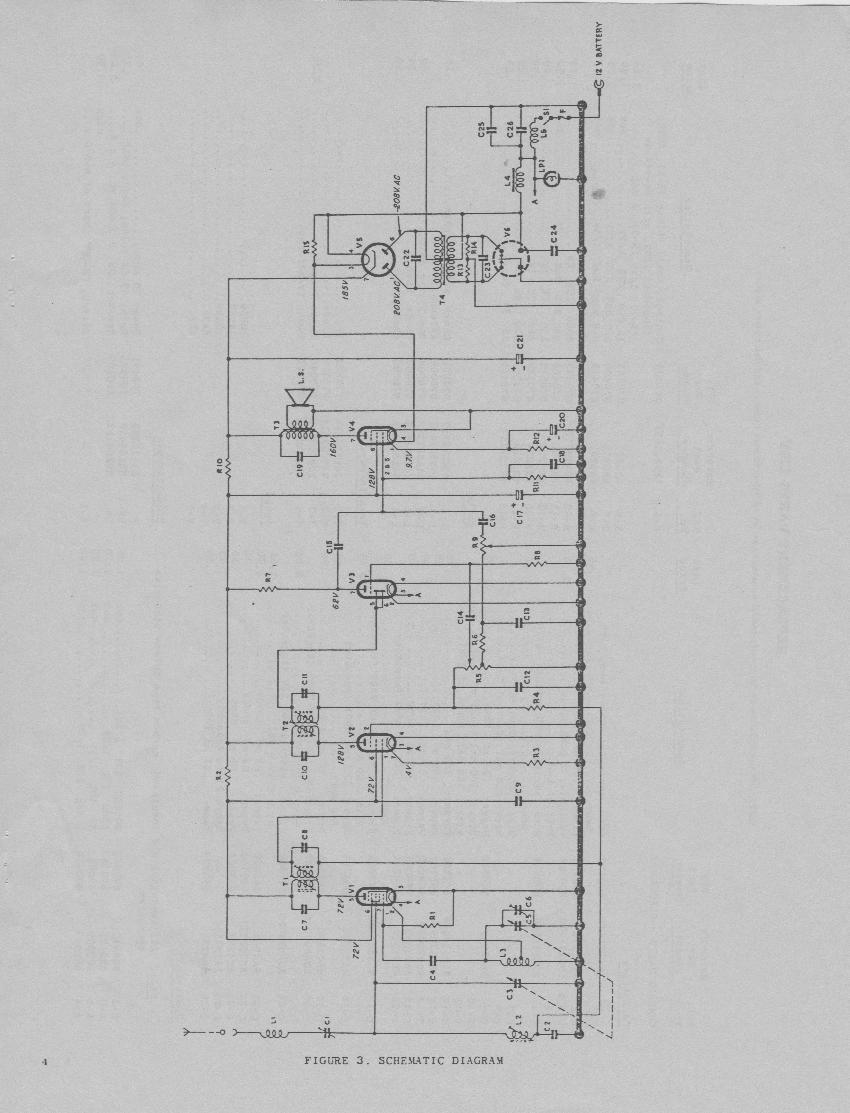
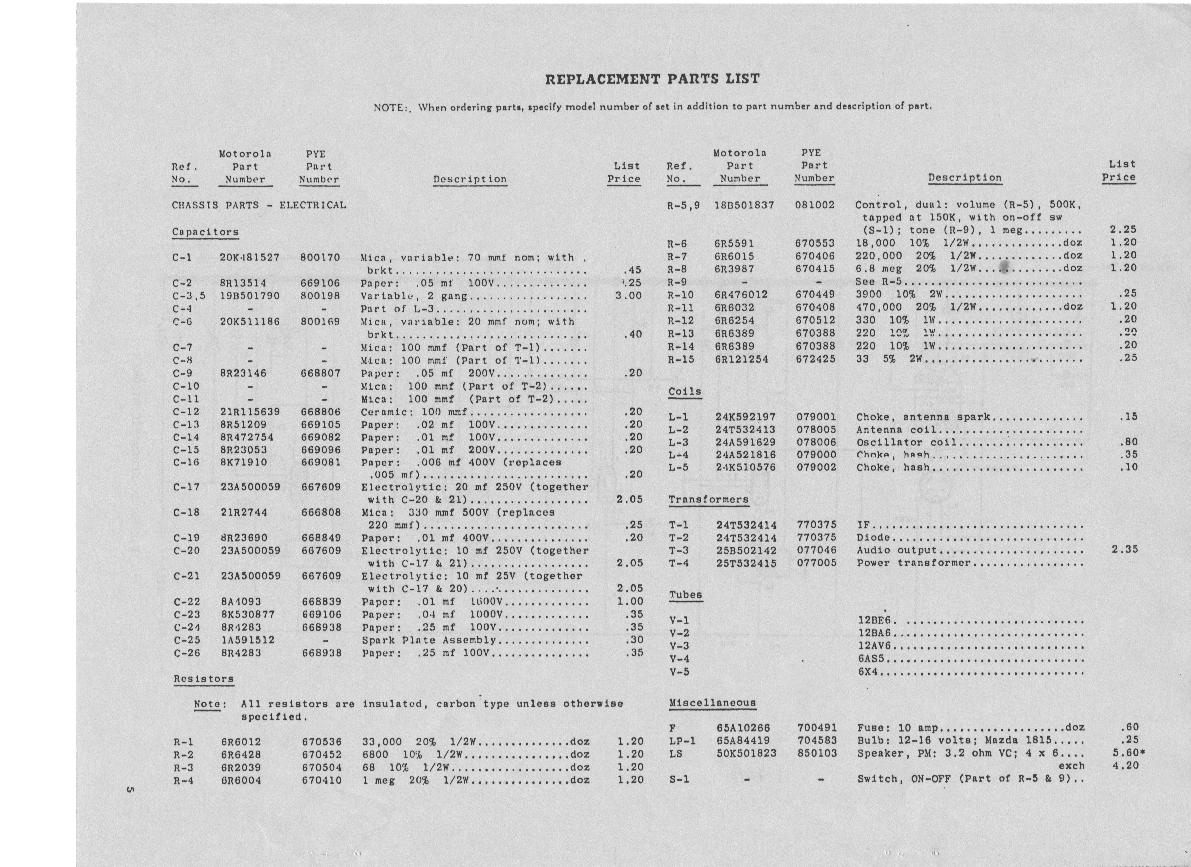
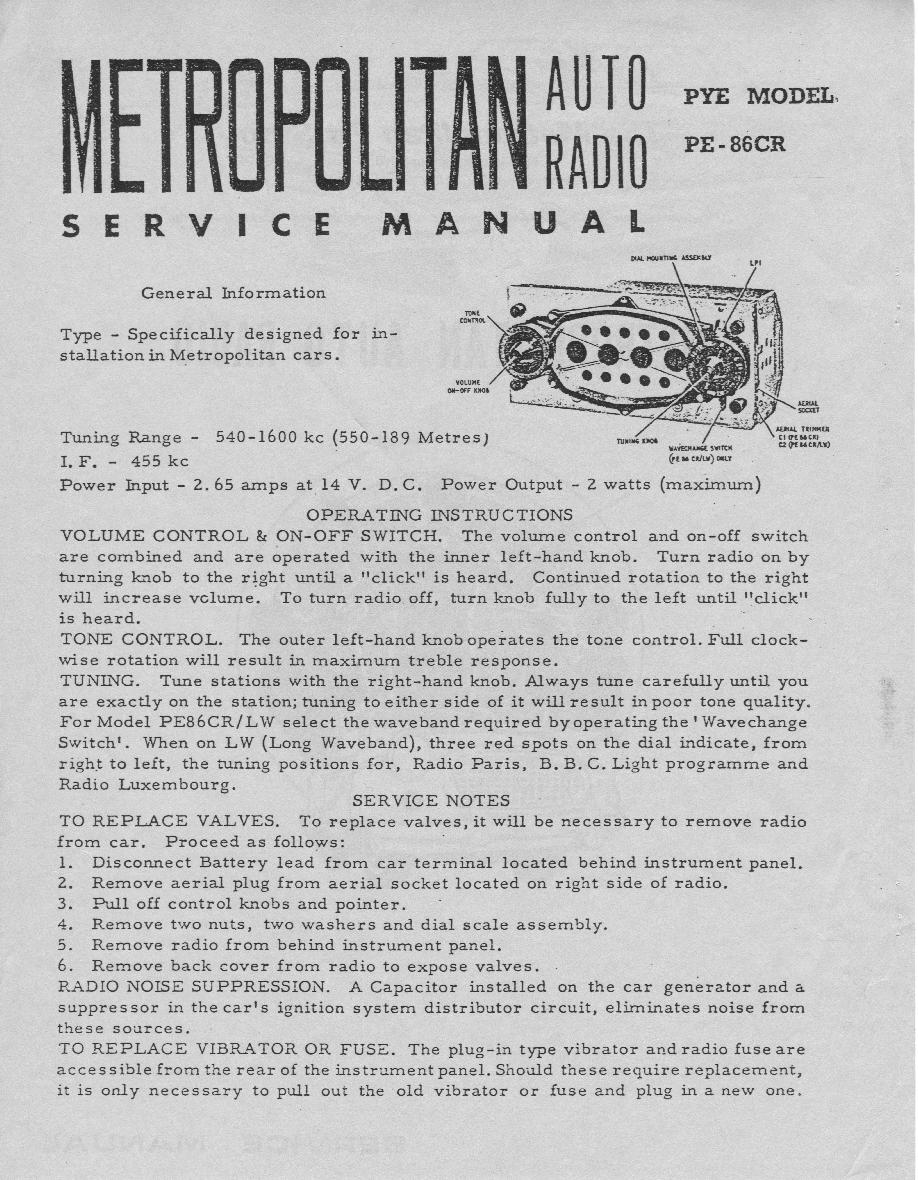
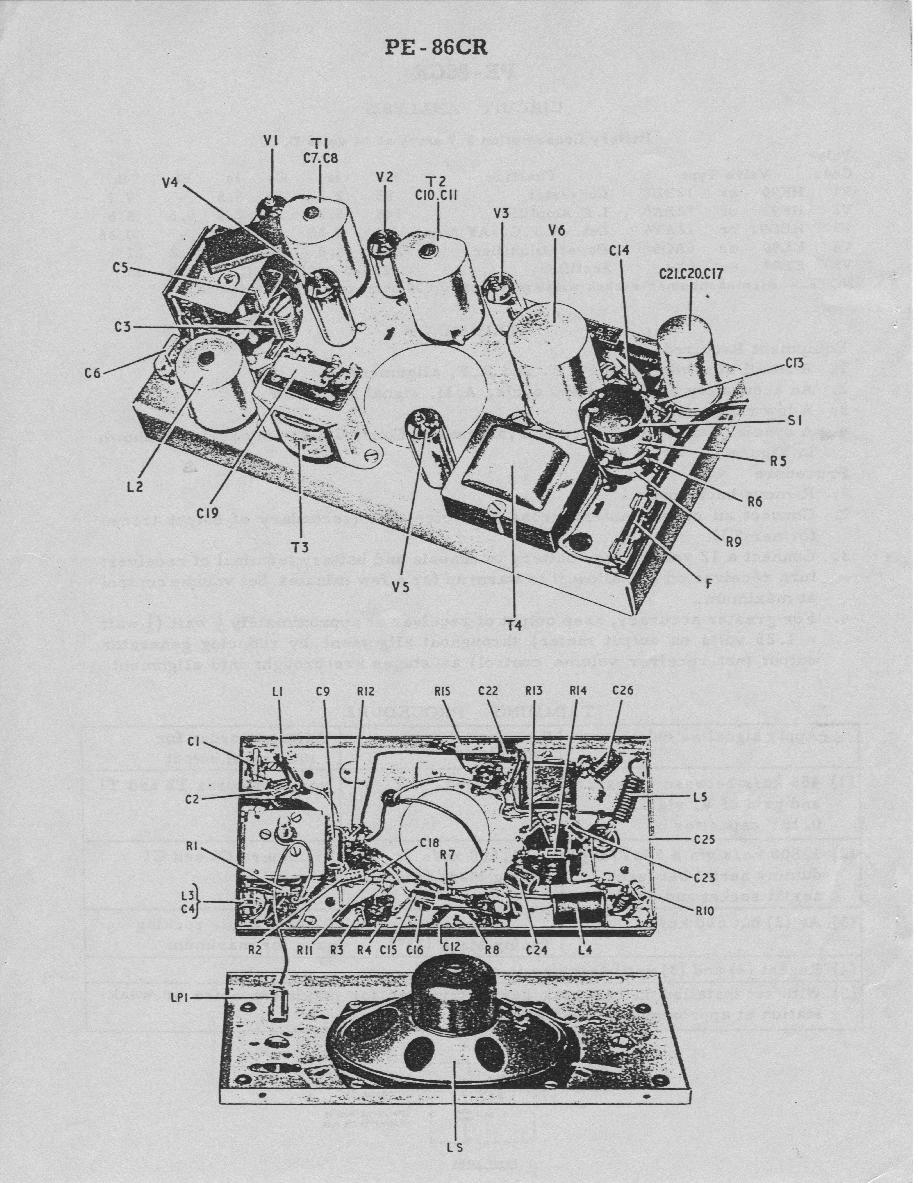
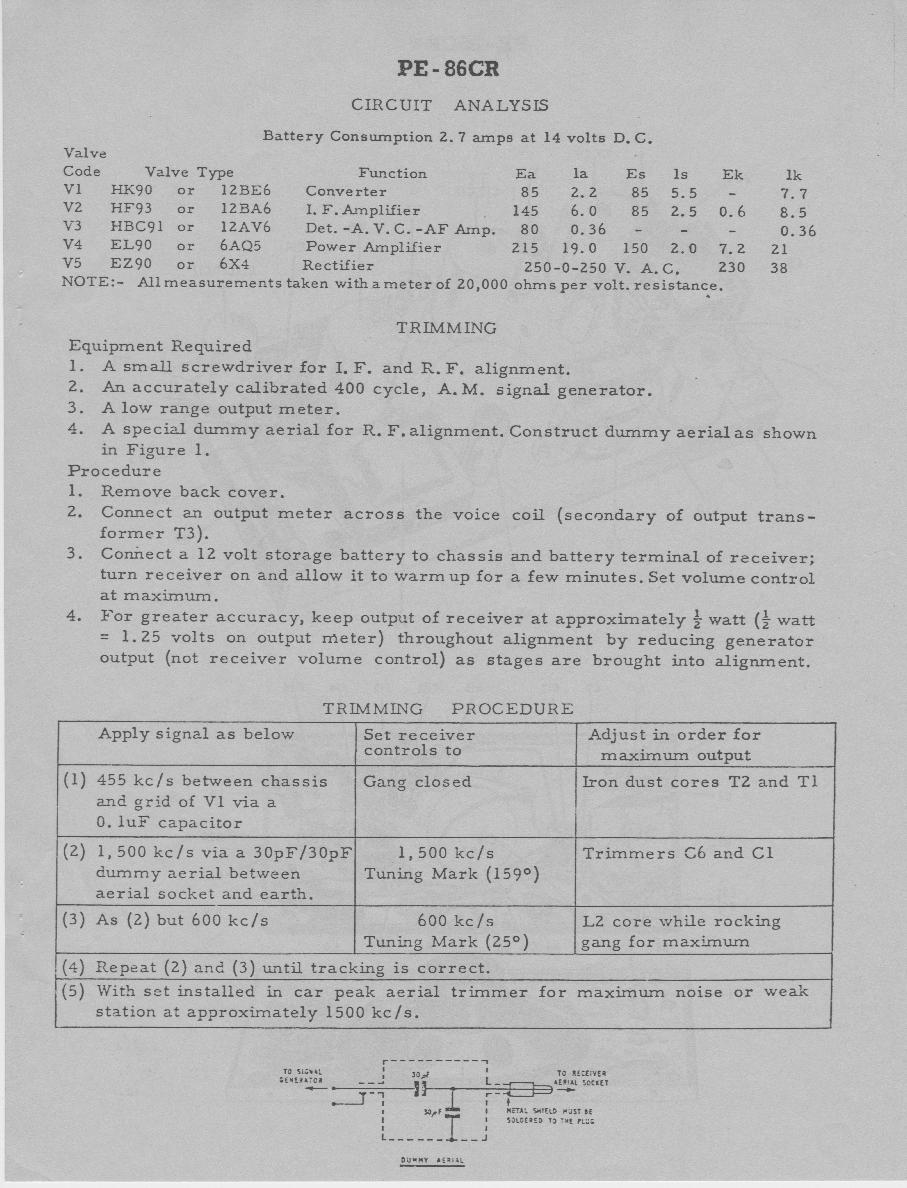
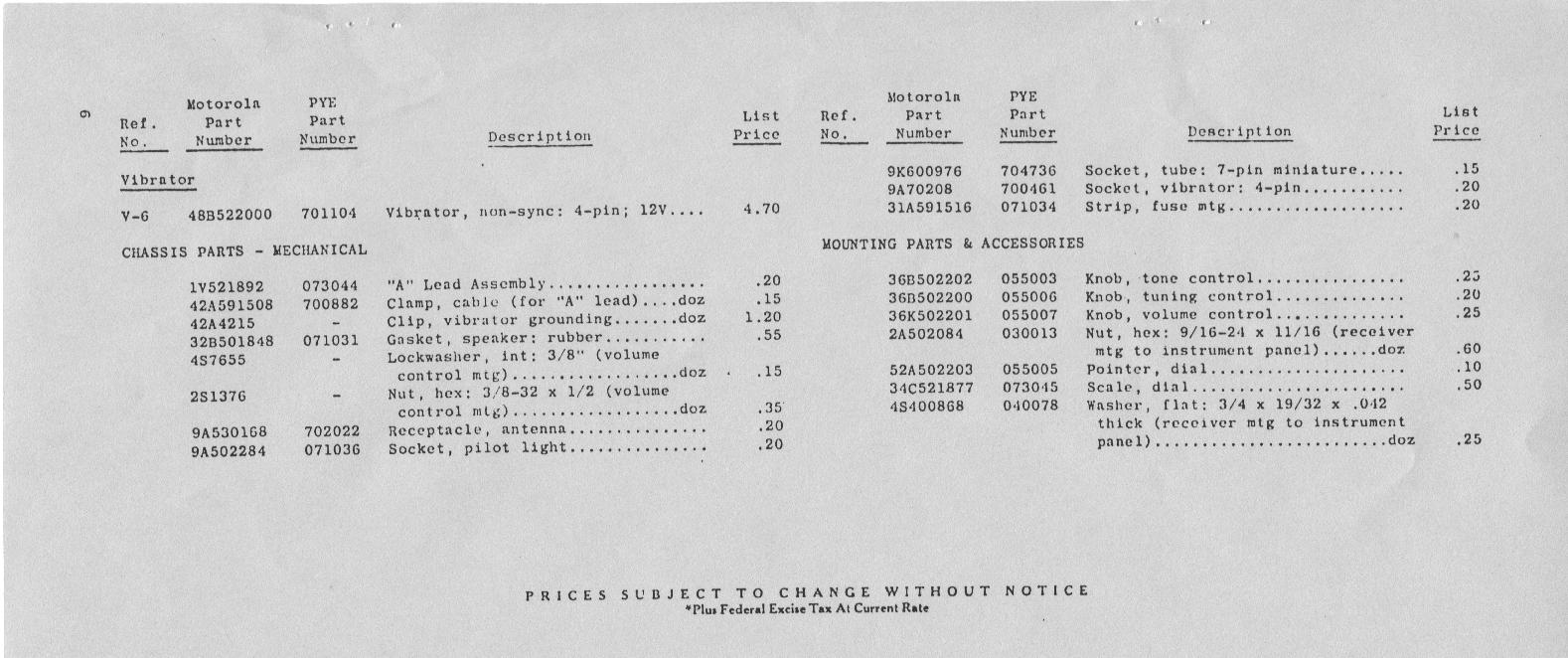
The '35 Nash Aeroform
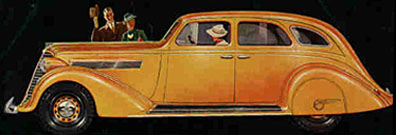
------------------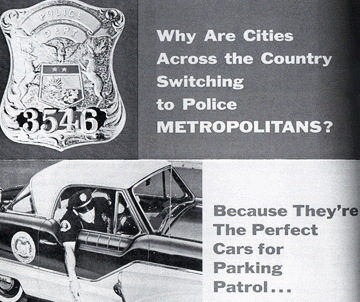
------------------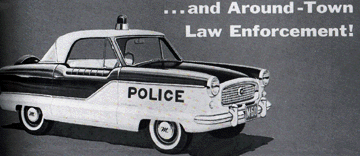
-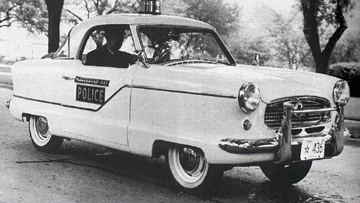 --
--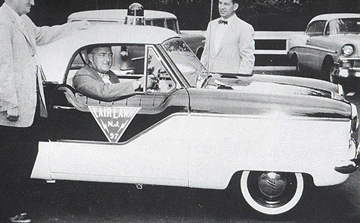
LARGE bumper guard and non-typical paint job
the mayor!
-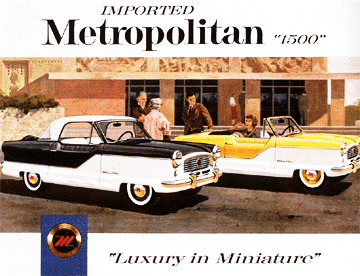 --
--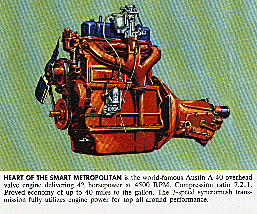
Here's the RED & BLUE engine w/BLACK fan
HEART OF THE SMART METROPOLITAN is the world-famous Austin
A-40 overhead valve engine delivering 42 horsepower at 4900 RPM.
Compression ratio 7.2:1. Proved economy of up to 40 miles to the
gallon. The 3 speed sychromesh transmission fully utilizes engine
power for top all around performance.
-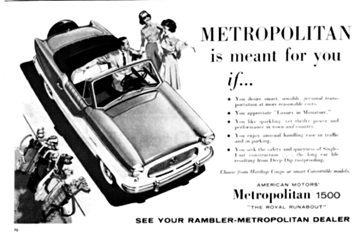 --
--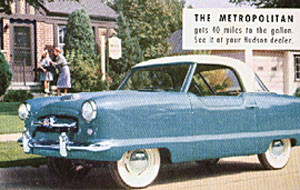
RAMBLER
Metropolitan ad
See it at your HUDSON dealer
-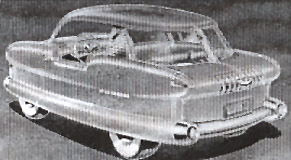 --
--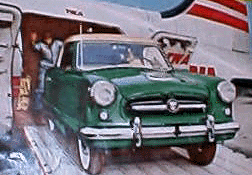
A Bill Flajole sketch
Gettin off the plane!
--
--

This 1942 picture of Grandma (Marie) and Grandpa (Clarence Everett) Christensen was given to me by Rose Marie Christensen Eid in June, 1998. That's me in the center and Robert Brunelle in Grandma's lap. I was born 22 DEC 1940 and am the oldest Christensen grandchild. Robert is the next in line. Grandma's maiden name is Ramon, as is my middle name. She once told me that it means red place, Rödmoen in Swedish. I think Grandpa (62?) died on Good Friday, 1956. Grandma (98 yrs & 10 mo) in Sep 1992. She was born in Big Woods MN - on the Snake River near Oslo, MN. The house where her mother lived after she arrived from Sweden, survives in Rosby, MN, a railroad siding just east of Bemidji, MN.
The folk's house, the only brick house in Gary, MN,
was built about 1894 -- The trees overhanging the house on the left, were
saplings in a 1911 picture. I remember when the house was bought
- 1948. Kenny piled Ma and us kids into the car and drove into town,
he stopped in front of the house and said "Look here, look what I bought
for you today." Ma hugged and kissed him and squirmed like a new
found puppy. The barn, in the back, was torn down after the tornado of
'78(?). A '47 and a '51 Nash were among the cars my Dad had.
I once met a man from Gary, (pop 250-) we BS'd a bit
and it turned out he had left 2 yrs before we moved to town and that he
had lived in the SAME house.
this is the very end
If you have comments, send a note to me: jrc@mninter.net
This page created with Netscape Navigator Gold